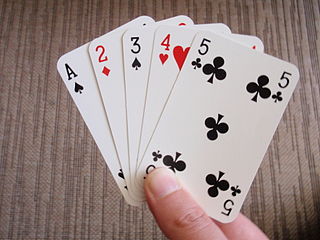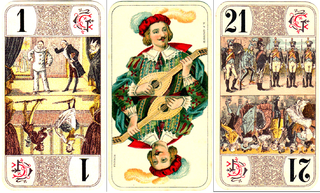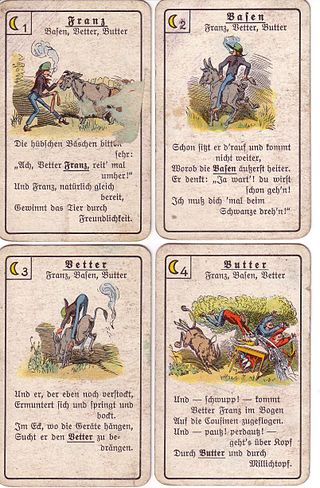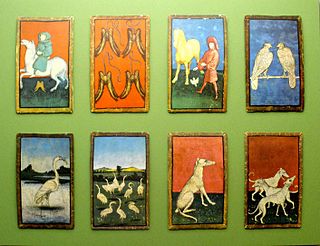
A playing card is a piece of specially prepared card stock, heavy paper, thin cardboard, plastic-coated paper, cotton-paper blend, or thin plastic that is marked with distinguishing motifs. Often the front (face) and back of each card has a finish to make handling easier. They are most commonly used for playing card games, and are also used in magic tricks, cardistry, card throwing, and card houses; cards may also be collected. Playing cards are typically palm-sized for convenient handling, and usually are sold together in a set as a deck of cards or pack of cards.
A stripped deck or short deck (US), short pack or shortened pack (UK), is a set of playing cards reduced in size from a full pack or deck by the removal of a certain card or cards. The removed cards are usually pip cards, but can also be court cards or Tarot cards. Many card games use stripped decks, and stripped decks for popular games are commercially available.

In playing cards, a suit is one of the categories into which the cards of a deck are divided. Most often, each card bears one of several pips (symbols) showing to which suit it belongs; the suit may alternatively or additionally be indicated by the color printed on the card. The rank for each card is determined by the number of pips on it, except on face cards. Ranking indicates which cards within a suit are better, higher or more valuable than others, whereas there is no order between the suits unless defined in the rules of a specific card game. In most decks, there is exactly one card of any given rank in any given suit. A deck may include special cards that belong to no suit, often called jokers.

The United States Playing Card Company is a large American producer and distributor of playing cards. It was established in 1867 as Russell, Morgan & Co. and founded in Cincinnati, Ohio in its current incarnation in 1885. Its many brands include Bicycle, Bee, Tally-Ho, Champion, Congress, Aviator, Aristocrat, Mohawk, Maverick, KEM, Hoyle and Fournier. It also produces novelty and custom playing cards, and other playing card accessories such as poker chips. For decades the company was based in Norwood, Ohio, but as of 2009, the USPC is currently headquartered in the Cincinnati suburb of Erlanger, Kentucky.

The standard 52-card deck of French-suited playing cards is the most common pack of playing cards used today. In English-speaking countries it is the only traditional pack used for playing cards; in many countries of the world, however, it is used alongside other traditional, often older, standard packs with different suit systems such as those with German-, Italian-, Spanish- or Swiss suits. The most common pattern of French-suited cards worldwide and the only one commonly available in English-speaking countries is the English pattern pack. The second most common is the Belgian-Genoese pattern, designed in France, but whose use spread to Spain, Italy, the Ottoman Empire, the Balkans and much of North Africa and the Middle East. In addition to those, there are other major international and regional patterns including standard 52-card packs, for example, in Italy that use Italian-suited cards. In other regions, such as Spain and Switzerland, the traditional standard pack comprises 36, 40 or 48 cards.
Rubber bridge is a form of contract bridge played by two competing pairs using a particular method of scoring. A rubber is completed when one pair becomes first to win two games, each game presenting a score of 100 or more contract points; a new game ensues until one pair has won two games to conclude the rubber. Owing to the availability of various additional bonus and penalty points in the scoring, it is possible, though less common, to win the rubber by amassing more total points despite losing two games out of three. Rubber bridge involves a high degree of skill but there is also a fair amount of luck involved in who gets the best cards. A popular variation of rubber bridge is known as Chicago.

A four-color deck (US) or four-colour pack (UK) is a deck of playing cards identical to the standard French deck except for the color of the suits. In a typical English four-color deck, hearts are red and spades are black as usual, but clubs are green and diamonds are blue. However, other color combinations have been used over the centuries, in other areas or for certain games.
Minchiate is an early 16th-century card game, originating in Florence, Italy. It is no longer widely played. Minchiate can also refer to the special deck of 97 playing cards used in the game. The deck is closely related to the tarot cards, but contains an expanded suit of trumps. The game was similar to but more complex than tarocchi. The minchiate represents a Florentine variant on the original game.

Cego is a Tarot card game for three or four players played mainly in and around the Black Forest region of Germany. It was probably derived from the three-player Badenese game of Dreierles when soldiers deployed from the Iberian Peninsula during the Napoleonic Wars and, based on a Spanish game they had encountered, introduced Cego's distinctive feature: a concealed hand, or blind. Cego has experienced a revival in recent years, being seen as part of the culture of the Black Forest and surrounding region. It has been called the national game of Baden and described as a "family classic".

The Bourgeois Tarot deck is a mid-19th century pattern of tarot cards of German origin that is used for playing card games in western Europe and Canada. It is not designed for divinatory purposes. This deck is most commonly found in France, Belgian Wallonia, Swiss Romandy and the Canadian province of Québec for playing French Tarot; in southwest Germany for playing Cego and Dreierles; and in Denmark for Danish Tarok.

Quartets is a dedicated deck card game with the object to collect 4 cards in a series, similar to Go Fish and Happy Families.

Animal Tarot is a genre of tarot decks used for playing card games that were most commonly found in northern Europe, from Belgium to Russia, only one of which has survived: the Adler Cego pattern in south Germany. A theme of animals, real and/or fantastic, replaces the traditional trump scenes found in the Italian-suited tarot packs such as the Tarot of Besançon. The Sküs plays a musical instrument while the Pagat is represented by Hans Wurst, a carnival stock character who carries his sausage, drink, slap stick, or hat. They constitute the first generation of French-suited tarot patterns. Prior to their introduction, tarot card games had been confined to Italy, France, and Switzerland. During the 17th century, the game's popularity in these three countries declined and was forgotten in many regions. The rapid expansion of the game into the Holy Roman Empire and Scandinavia after the appearance of animal tarots may not be a coincidence. In the 19th century, most animal tarots were replaced with tarots that have genre scenes, veduta, opera, architecture, or ethnological motifs on the trumps such as the Industrie und Glück of Austria-Hungary.

Trappola is an early 16th-century Venetian trick-taking card game which spread to most parts of Central Europe and survived, in various forms and under various names like Trapulka, Bulka and Hundertspiel until perhaps the middle of the 20th century. It was played with a special pack of Italian-suited cards and last reported to have been manufactured in Prague in 1944. Piatnik has reprinted their old Trappola deck for collectors.

The following is a glossary of terms used in card games. Besides the terms listed here, there are thousands of common and uncommon slang terms. Terms in this glossary should not be game-specific, but apply to a wide range of card games played with non-proprietary packs. It should not include terms solely related to casino or banking games. For glossaries that relate primarily to one game or family of similar games, see Game-specific glossaries.

The Ambraser Hofjagdspiel is a pack of cards painted around 1440–1445 and attributed to the engraver Konrad Witz from Basel, Switzerland. It originally consisted of fifty-six cards from which only 54 survive, all distributed in four suits, falcons, lures, hounds and herons, symbols related to hunting. Each suit contained ten pip cards with the 10s being represented by a banner like many old German playing cards and modern Swiss playing cards. There are four face cards per suit: the Unter, Ober, Queen, and King. It was found in a collection at the Ambras Castle, in Innsbruck, Austria, in the 16th century, and now figures as a precious item in the collection of cards of the Kunsthistorisches Museum in Vienna.

German-suited playing cards are a very common style of traditional playing card used in many parts of Central Europe characterised by 32- or 36-card packs with the suits of Acorns, Leaves, Hearts and Bells. The German suit system is one of the oldest, becoming standard around 1450 and, a few decades later, influencing the design of the now international French suit system of Clubs, Spades, Hearts and Diamonds. Today German-suited playing cards are common in south and east Germany, Austria, German-speaking Switzerland, Liechtenstein, north Italy, Hungary, Czech Republic, Slovakia, Slovenia, Croatia, Bosnia, northern Serbia, southern Poland and central and western Romania.

French-suited playing cards or French-suited cards are cards that use the French suits of trèfles, carreaux, cœurs, and piques. Each suit contains three or four face/court cards. In a standard 52-card deck these are the valet, the dame, and the roi (king). In addition, in Tarot packs, there is a cavalier (cavalier) ranking between the queen and the jack. Aside from these aspects, decks can include a wide variety of regional and national patterns, which often have different deck sizes. In comparison to Spanish, Italian, German, and Swiss playing cards, French cards are the most widespread due to the geopolitical, commercial, and cultural influence of France, the United Kingdom, and the United States in the 19th and 20th centuries. Other reasons for their popularity were the simplicity of the suit insignia, which simplifies mass production, and the popularity of whist and contract bridge. The English pattern of French-suited cards is so widespread that it is also known as the International or Anglo-American pattern.

Industrie und Glück is a pattern of French suited playing cards used to play tarock. The name originates from an inscription found on the second trump card. This deck was developed during the nineteenth century in the Austro-Hungarian Empire. The earliest known examples were made in Vienna in 1815. After the collapse of the empire in World War I, it remained the most widely used tarot deck in Central Europe and can be found throughout the former parts of the empire.

Tapp Tarock, also called Viennese Tappen, Tappen or Tapper, is a three-player tarot card game which traditionally uses the 54-card Industrie und Glück deck. Before the Anschluss (1938), it was the preferred card game of Viennese coffee houses, for example, the Literatencafés and Café Central. Even today Tapp Tarock is played sporadically. The exact date when it appeared is not possible to identify; some sources suggest it may have been developed in Austria in the early 19th century, but its mention in caricature operas in 1800 and 1806 suggest it was well known even by then and must have arisen in the late 18th century. The oldest description of the actual rules is dated to 1821. Tapp Tarock is considered a good entry level game before players attempt more complex Tarock forms like Cego, Illustrated Tarock or Königrufen.

Droggn, sometimes called French Tarock is an extinct card game of the Tarock family for three players that was played in the Stubai valley in Tyrol, Austria until the 1980s. Droggn is originally local dialect for "to play Tarock", but it has become the proper name of this specific Tarock variant. An unusual feature of the game compared with other Tarock games is the use of a 66-card deck and that, until recently, there was no record in the literature of a 66-card game and no current manufacturers of such a deck. The structure of the game strongly indicates that it is descended from the later version of Tarok l'Hombre, a 78-card Tarock game popular in 19th-century Austria and Germany, but with the subsequent addition of two higher bids.


















